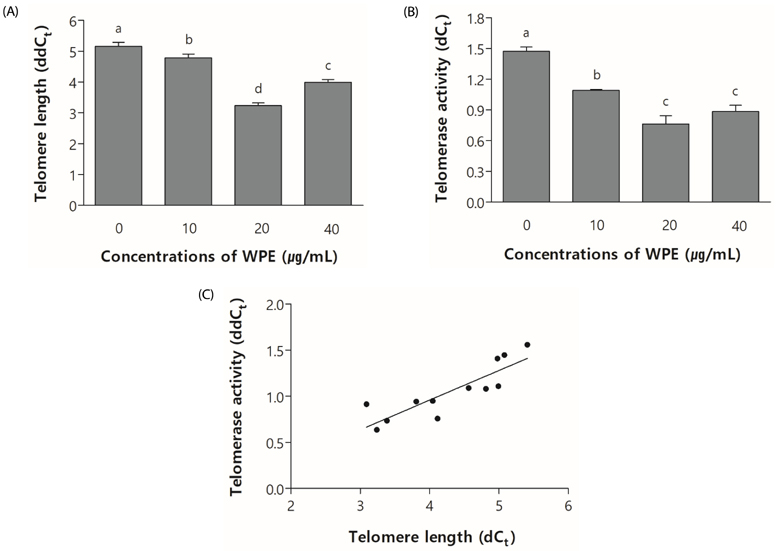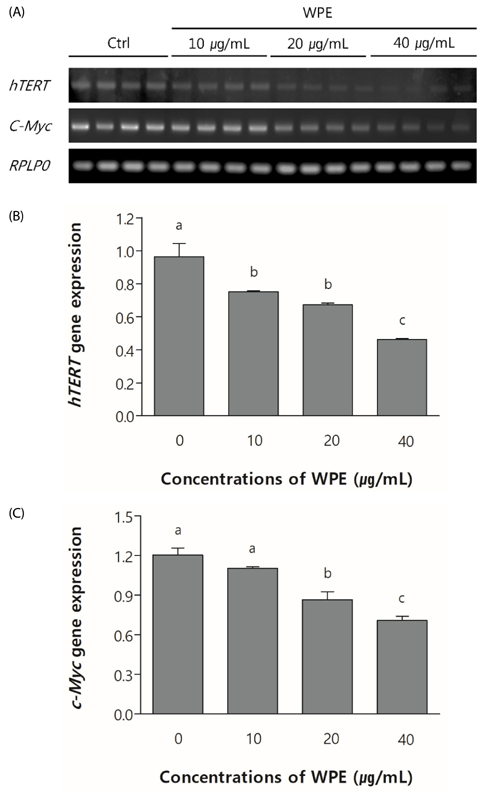Nutr Res Pract.
2019 Feb;13(1):58-63. 10.4162/nrp.2019.13.1.58.
Walnut phenolic extracts reduce telomere length and telomerase activity in a colon cancer stem cell model
- Affiliations
-
- 1CHA University School of Medicine, 120, Haeryong-ro, Pocheon-si, Gyeonggi 13488, Korea. sang.choi@cha.ac.kr
- 2Division of Nutrition and Metabolism, Korea Food Research Institute, Jeonju, Jeonbuk 55365, Korea.
- 3Department of Nutritional Science and Food Management, Ewha Womans University, Seoul, 03760, Korea.
- 4Chaum Life Center CHA University, 442, Dosan-daero, Gangnam-gu, Seoul, 06062, Korea.
- KMID: 2434077
- DOI: http://doi.org/10.4162/nrp.2019.13.1.58
Abstract
- BACKGROUND/OBJECTIVES
Telomeres are located at the chromosomal ends and progressively shortened during each cell cycle. Telomerase, which is regulated by hTERT and c-MYC, maintains telomeric DNA sequences. Especially, telomerase is active in cancer and stem cells to maintain telomere length for replicative immortality. Recently we reported that walnut phenolic extract (WPE) can reduce cell viability in a colon cancer stem cell (CSC) model. We, therefore, investigated the effect of WPE on telomere maintenance in the same model.
MATERIALS/METHODS
CD133+CD44+ cells from HCT116, a human colon cancer cell line, were sorted by Fluorescence-activated cell sorting (FACS) and treated with WPE at the concentrations of 0, 10, 20, and 40 µg/mL for 6 days. Telomere lengths were assessed by quantitative real-time PCR (qRT-PCR) using telomere specific primers and DNA extracted from the cells, which was further adjusted with single-copy gene and reference DNA (ddCt ). Telomerase activity was also measured by qRT-PCR after incubating the PCR mixture with cell protein extracts, which was adjusted with reference DNA (dCt ). Transcriptions of hTERT and c-MYC were determined using conventional RT-PCR.
RESULTS
Telomere length of WPE-treated cells was significantly decreased in a dose-dependent manner (5.16 ± 0.13 at 0 µg/mL, 4.79 ± 0.12 at 10 µg/mL, 3.24 ± 0.08 at 20 µg/mL and 3.99 ± 0.09 at 40 µg/mL; P = 0.0276). Telomerase activities concurrently decreased with telomere length (1.47 ± 0.04, 1.09 ± 0.01, 0.76 ± 0.08, and 0.88 ± 0.06; P = 0.0067). There was a positive correlation between telomere length and telomerase activity (r = 0.9090; P < 0.0001). Transcriptions of both hTERT and c-MYC were also significantly decreased in the same manner.
CONCLUSIONS
In the present cell culture model, WPE reduced telomere maintenance, which may provide a mechanistic link to the effect of walnuts on the viability of colon CSCs.
Keyword
MeSH Terms
Figure
Reference
-
1. Sabaté J, Ang Y. Nuts and health outcomes: new epidemiologic evidence. Am J Clin Nutr. 2009; 89:1643S–1648S.
Article2. Yu Z, Malik VS, Keum N, Hu FB, Giovannucci EL, Stampfer MJ, Willett WC, Fuchs CS, Bao Y. Associations between nut consumption and inflammatory biomarkers. Am J Clin Nutr. 2016; 104:722–728.
Article3. Calcabrini C, De Bellis R, Mancini U, Cucchiarini L, Stocchi V, Potenza L. Protective effect of Juglans regia L. walnut extract against oxidative DNA damage. Plant Foods Hum Nutr. 2017; 72:192–197.
Article4. Feldman EB. The scientific evidence for a beneficial health relationship between walnuts and coronary heart disease. J Nutr. 2002; 132:1062S–1101S.
Article5. Tsoukas MA, Ko BJ, Witte TR, Dincer F, Hardman WE, Mantzoros CS. Dietary walnut suppression of colorectal cancer in mice: mediation by miRNA patterns and fatty acid incorporation. J Nutr Biochem. 2015; 26:776–783.
Article6. Lee J, Kim YS, Lee J, Heo SC, Lee KL, Choi SW, Kim Y. Walnut phenolic extract and its bioactive compounds suppress colon cancer cell growth by regulating colon cancer stemness. Nutrients. 2016; 8:E439.
Article7. Rampazzo E, Bertorelle R, Serra L, Terrin L, Candiotto C, Pucciarelli S, Del Bianco P, Nitti D, De Rossi A. Relationship between telomere shortening, genetic instability, and site of tumour origin in colorectal cancers. Br J Cancer. 2010; 102:1300–1305.
Article8. Zhang C, Chen X, Li L, Zhou Y, Wang C, Hou S. The association between telomere length and cancer prognosis: evidence from a meta-analysis. PLoS One. 2015; 10:e0133174.
Article9. Zhao Y, Cheng D, Wang S, Zhu J. Dual roles of c-Myc in the regulation of hTERT gene. Nucleic Acids Res. 2014; 42:10385–10398.
Article10. Rana C, Piplani H, Vaish V, Nehru B, Sanyal SN. Downregulation of telomerase activity by diclofenac and curcumin is associated with cell cycle arrest and induction of apoptosis in colon cancer. Tumour Biol. 2015; 36:5999–6010.
Article11. Leão R, Apolónio JD, Lee D, Figueiredo A, Tabori U, Castelo-Branco P. Mechanisms of human telomerase reverse transcriptase (hTERT) regulation: clinical impacts in cancer. J Biomed Sci. 2018; 25:22.
Article12. Miller DM, Thomas SD, Islam A, Muench D, Sedoris K. c-Myc and cancer metabolism. Clin Cancer Res. 2012; 18:5546–5553.
Article13. Choi J, Shin PK, Kim Y, Hong CP, Choi SW. Metabolic influence of walnut phenolic extract on mitochondria in a colon cancer stem cell model. Eur J Nutr. Forthcoming 2018.
Article14. Anderson KJ, Teuber SS, Gobeille A, Cremin P, Waterhouse AL, Steinberg FM. Walnut polyphenolics inhibit in vitro human plasma and LDL oxidation. J Nutr. 2001; 131:2837–2842.15. Min SJ, Lim JY, Kim HR, Kim SJ, Kim Y. Sasa quelpaertensis leaf extract inhibits colon cancer by regulating cancer cell stemness in vitro and in vivo. Int J Mol Sci. 2015; 16:9976–9997.
Article16. Cawthon RM. Telomere measurement by quantitative PCR. Nucleic Acids Res. 2002; 30:e47.
Article17. Hou M, Xu D, Björkholm M, Gruber A. Real-time quantitative telomeric repeat amplification protocol assay for the detection of telomerase activity. Clin Chem. 2001; 47:519–524.
Article18. Sadr M, Noori Mugahi SM, Hassanzadeh G, Nadji SA, Kiani A, Abedini A, Javadi A, Mohammadi F, Masjedi MR, Bahadori M. Telomere shortening in blood leukocytes of patients with chronic obstructive pulmonary disease. Tanaffos. 2015; 14:10–16.19. Herbert BS, Hochreiter AE, Wright WE, Shay JW. Nonradioactive detection of telomerase activity using the telomeric repeat amplification protocol. Nat Protoc. 2006; 1:1583–1590.
Article20. Liu T, Liang X, Li B, Björkholm M, Jia J, Xu D. Telomerase reverse transcriptase inhibition stimulates cyclooxygenase 2 expression in cancer cells and synergizes with celecoxib to exert anti-cancer effects. Br J Cancer. 2013; 108:2272–2280.
Article21. Duangmano S, Dakeng S, Jiratchariyakul W, Suksamrarn A, Smith DR, Patmasiriwat P. Antiproliferative effects of cucurbitacin B in breast cancer cells: down-regulation of the c-Myc/hTERT/telomerase pathway and obstruction of the cell cycle. Int J Mol Sci. 2010; 11:5323–5338.
Article22. Rozen S, Skaletsky H. Primer3 on the WWW for general users and for biologist programmers. Methods Mol Biol. 2000; 132:365–386.
Article23. Gilley D, Tanaka H, Herbert BS. Telomere dysfunction in aging and cancer. Int J Biochem Cell Biol. 2005; 37:1000–1013.
Article24. Aviv A, Anderson JJ, Shay JW. Mutations, cancer and the telomere length paradox. Trends Cancer. 2017; 3:253–258.
Article25. Astuti Y, Wardhana A, Watkins J, Wulaningsih W, Network PR. PILAR Research Network. Cigarette smoking and telomere length: a systematic review of 84 studies and meta-analysis. Environ Res. 2017; 158:480–489.
Article26. Ennour-Idrissi K, Maunsell E, Diorio C. Telomere length and breast cancer prognosis: a systematic review. Cancer Epidemiol Biomarkers Prev. 2017; 26:3–10.
Article27. Fang X, Hu T, Yin H, Yang J, Tang W, Hu S, Xu X. Differences in telomerase activity and the effects of AZT in aneuploid and euploid cells in colon cancer. Int J Oncol. 2017; 51:525–532.
Article28. Martin SL, Kala R, Tollefsbol TO. Mechanisms for the inhibition of colon cancer cells by sulforaphane through epigenetic modulation of microRNA-21 and human telomerase reverse transcriptase (hTERT) down-regulation. Curr Cancer Drug Targets. 2018; 18:97–106.
Article29. Zhdanov DD, Pokrovsky VS, Pokrovskaya MV, Alexandrova SS, Eldarov MA, Grishin DV, Basharov MM, Gladilina YA, Podobed OV, Sokolov NN. Inhibition of telomerase activity and induction of apoptosis by rhodospirillum rubrum L-asparaginase in cancer Jurkat cell line and normal human CD4+ T lymphocytes. Cancer Med. 2017; 6:2697–2712.
Article30. Lu Y, Leong W, Guérin O, Gilson E, Ye J. Telomeric impact of conventional chemotherapy. Front Med. 2013; 7:411–417.
Article31. Marfil V, Blazquez M, Serrano F, Castell JV, Bort R. Growth-promoting and tumourigenic activity of c-Myc is suppressed by Hhex. Oncogene. 2015; 34:3011–3022.
Article
- Full Text Links
- Actions
-
Cited
- CITED
-
- Close
- Share
- Similar articles
-
- New Functions for Telomerase
- Telomerase Activity in Laryngeal Papilloma
- Relationship between Clinicopathological Characteristics and Telomerase Activity of Renal Cell Carcinoma
- Telomerase: Key to Mortal or Immortal Road
- Significance of Telomerase Activity as the Prognostic Factor of Human Bladder Cancer



